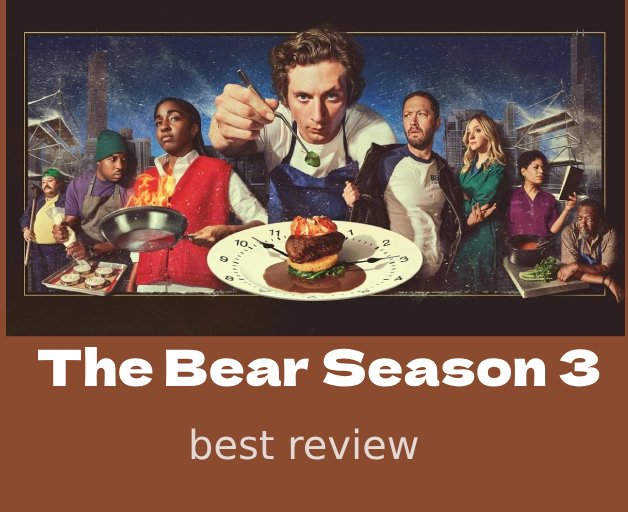Introduction (The Bear Season 3 best review )
In this comprehensive review of The Bear Season 3, we explore every aspect: the nonlinear narrative, deeper trauma arcs, key episodes, standout performances, and why the season earned both praise and backlash. Read on to get a vivid, unfiltered take on how this season expanded—and tested—the show’s identity.
Setting and Premise
Season 3 continues after the restaurant’s opening, focusing on the Bear team striving for a Michelin star. Carmy (Jeremy Allen White) pushes rigid standards and menu changes, while Richie (Ebon Moss‑Bachrach) grapples with his role in front of house, and Sydney (Ayo Edebiri) begins to question her emotional and professional load. The reopening of the beef window and the restaurant’s grind return The Bear’s familiar chaos to the spotlight.
Main Characters and Performances
- Carmy Berzatto (Jeremy Allen White): Haunted by grief and perfectionism, season 3 reveals the full extent of the trauma driving his behavior—from smoking cessation motivated by efficiency, to daily neuroses over precision.
- Sydney Adamu (Ayo Edebiri): The calming force in the kitchen, she cracks under pressure and questions her future, even as she partners with Carmy’s vision.
- Richie Jerimovich (Ebon Moss‑Bachrach): Emotionally volatile, Richie continues wrestling with trust and identity in the restaurant family.
- Tina Marrero (Liza Colón‑Zayas): Her backstory unfolds in “Napkins,” showing how she became part of the kitchen through compassion. Her origin story is moving and integral.
- Marcus Brooks (Lionel Boyce): Continues grieving his mother while anchoring the pastry line with emotional fragility and devotion.
- Natalie “Sugar” Berzatto (Abby Elliott) and guest Donna (Jamie Lee Curtis): In episode “Ice Chips,” a powerful childbirth story offers raw emotional reconciliation between mother and daughter.
- Jon Bernthal returns as Mikey in flashbacks, offering key emotional insights into Carmy’s past.
Story and Episode Highlights
Season 3’s ten episodes abandon linear plot momentum in favor of intense character studies. Episode 1, “Tomorrow”, is nearly dialogue‑free, montaging Carmy’s past and emotional triggers to set tone and mood.
Episode 6, “Napkins”, directed by Ayo Edebiri, offers Tina’s origin and is widely hailed as one of the season’s. Episode ? “Ice Chips” delivers powerful emotional resonance in a hospital birth scene and climate‑chained generational trauma arc. Other episodes double down on Carmy’s internal chaos through flashbacks, high-pressure service, and personality clashes—rebelling against linear momentum but reinforcing the show’s immersive intensity.
Themes and Emotional Core
Season 3 dives into trauma, identity, and perfectionism. Carmy’s incessant menu tinkering, non-negotiables, and cigarette quitting reflect obsessive control rooted in grief. The show mirrors this chaos via montage-heavy storytelling that echoes mental intensity.
Themes of care, interdependence, and generational wounds emerge through Tina’s background, sibling bonds, and parenting arcs—with food as both metaphoric and literal sustenance.
Visual and Sound Design
Season 3 adopts a more artistic and ambient style. The opening montage is atmospheric, trading dialogue for mood and music. The pacing ebbs, creating rhythm that ranges from frenetic to contemplative—film as a lyrical album rather than traditional broadcast storytelling.
Why Season 3 Polarized Audiences
Critics awarded The Bear Season 3 an 89% critic score on Rotten Tomatoes, but audience scores fell to 59% reflecting division over its unconventional structure. Some hailed it as emotionally daring: slow burn character portraits, standout episodes, and stylized immersion.
Others found it unfocused, repetitive, and lacking the narrative drive of prior seasons. Even critics acknowledged the unevenness but clarified that this mirror Carmy’s psyche rather than a flaw in craft.
Full Review Section – Deep and Detailed
Season 3 begins with Carmy haunted by ghosts—literally and figuratively. Episode 1’s ambient montage sets the tone: past mentors, grief-laden flashbacks, and prep rituals that teeter on obsession. We see Carmy’s menu becoming a rigid, evolving ritual—an anxiety-based devotion to perfection. Throughout, his relationships fracture: with Sydney, who grows weary of his intensity; with Richie, who remains cynical; and with himself, as unresolved wounds resurface.
Midseason, Tina’s arc provides a quiet emotional counterpoint. We watch her evolve from vulnerability to competency through a simple act of kindness from Mikey and bonding over shared loss in “Napkins”—a quiet pivot from chaos to poignancy.
The season builds toward “Ice Chips,” a chamber piece of labor and motherhood. Natalie’s labor with Donna’s fraught presence becomes a vessel for unresolved family grief—and its beautiful stillness yields some of the season’s most delicate emotional notes.
Yet not everything resolves: Carmy’s emotional regression, Sydney’s growing distance, and narrative unresolvedness mirror real psychological inertia. The season ends with an ambiguous Chicago Tribune review and Carmy’s trademark utterance—leaving both character and viewer suspended.
Conclusion – the bear season 3 best review
Season 3 of The Bear is bold, unconventional television. It breaks from traditional plot in favor of emotional vignettes—immersing viewers in trauma and tension through form and rhythm. While it may lack the clear narrative arcs of Seasons 1 and 2, it compensates with unmatched emotional depth, standout single-character episodes, and performances that continue to impress. Whether it became your favorite or your least, it remains undeniably The Bear, redefined.
Go to main page


